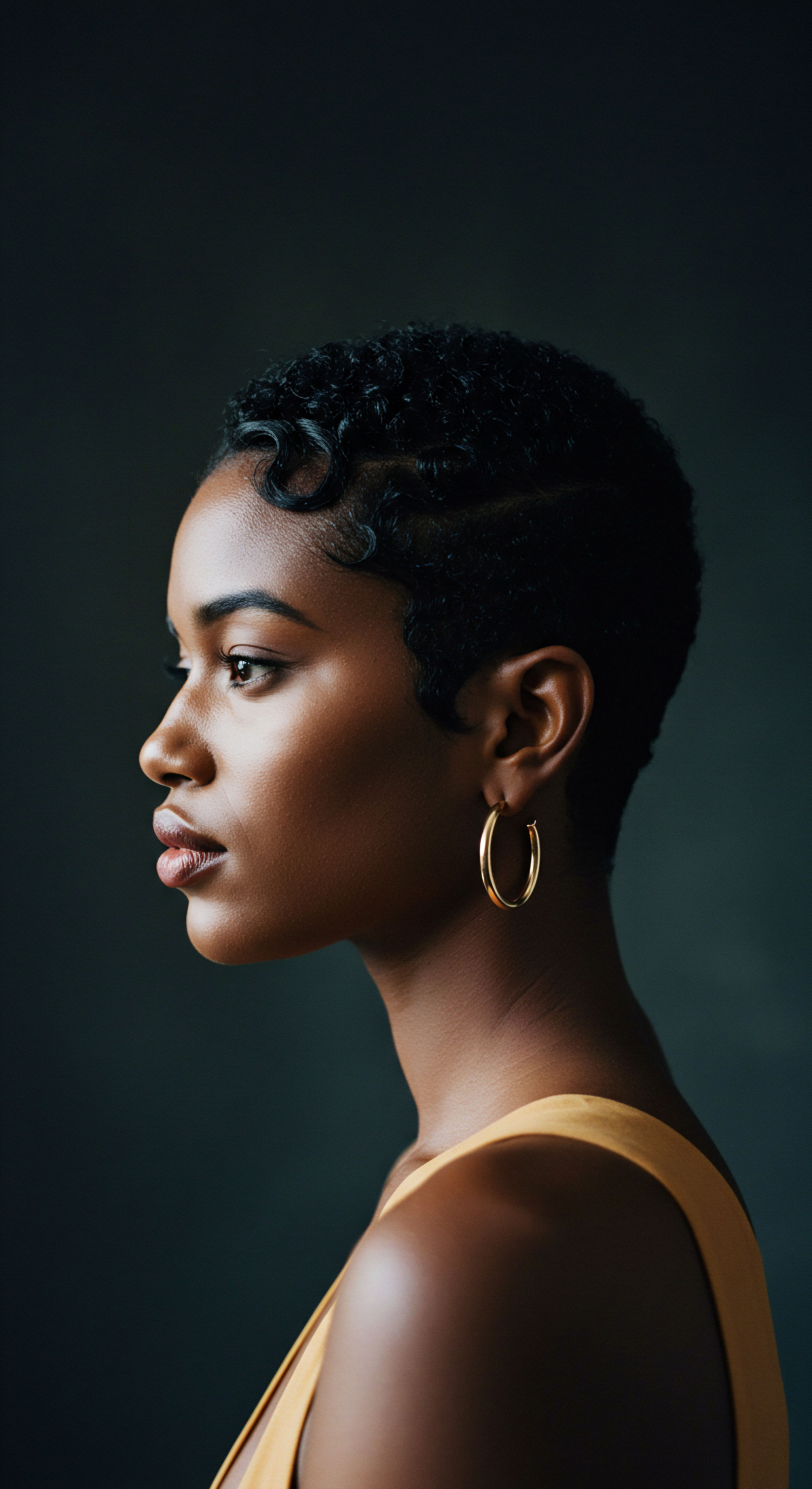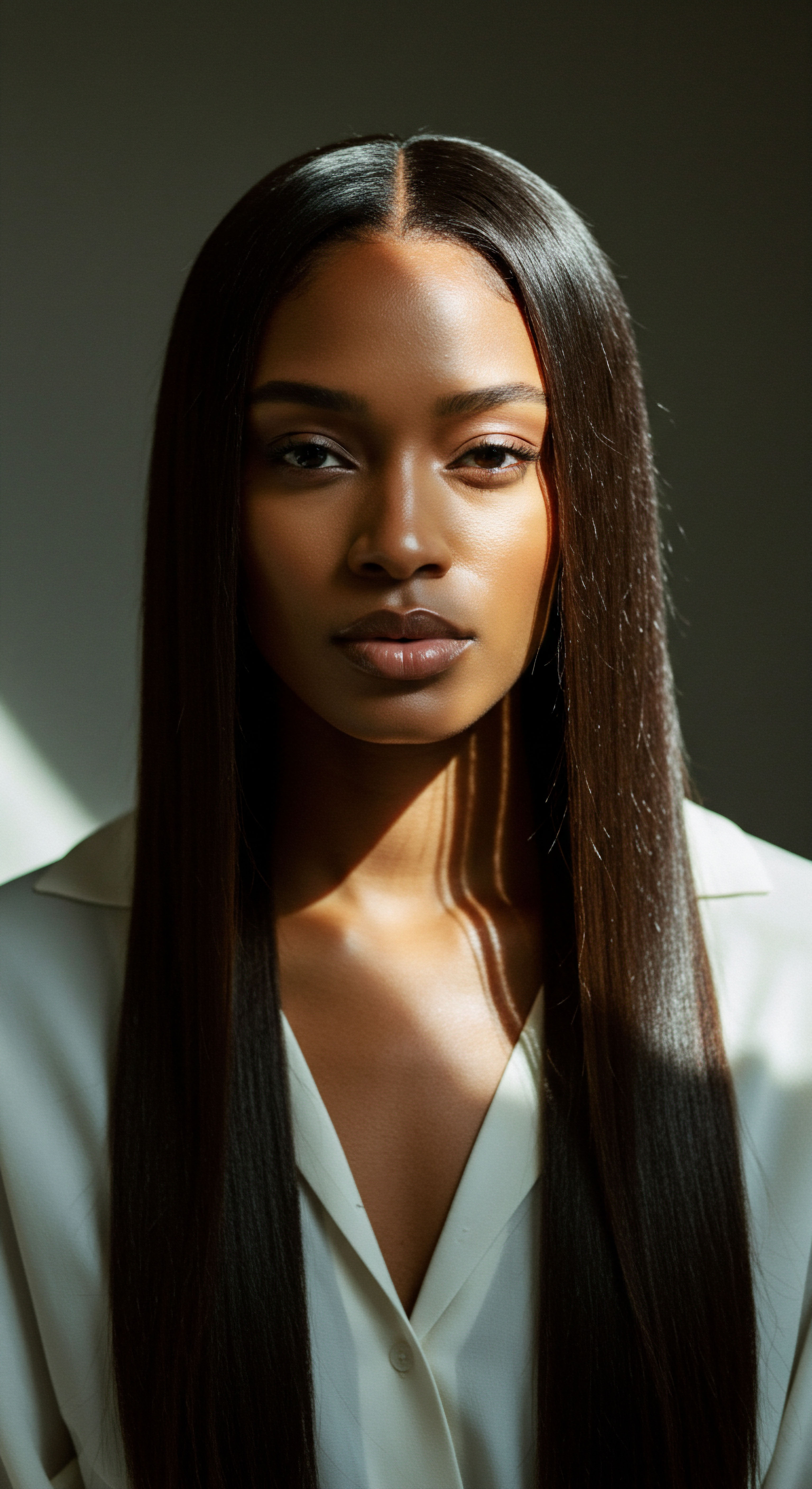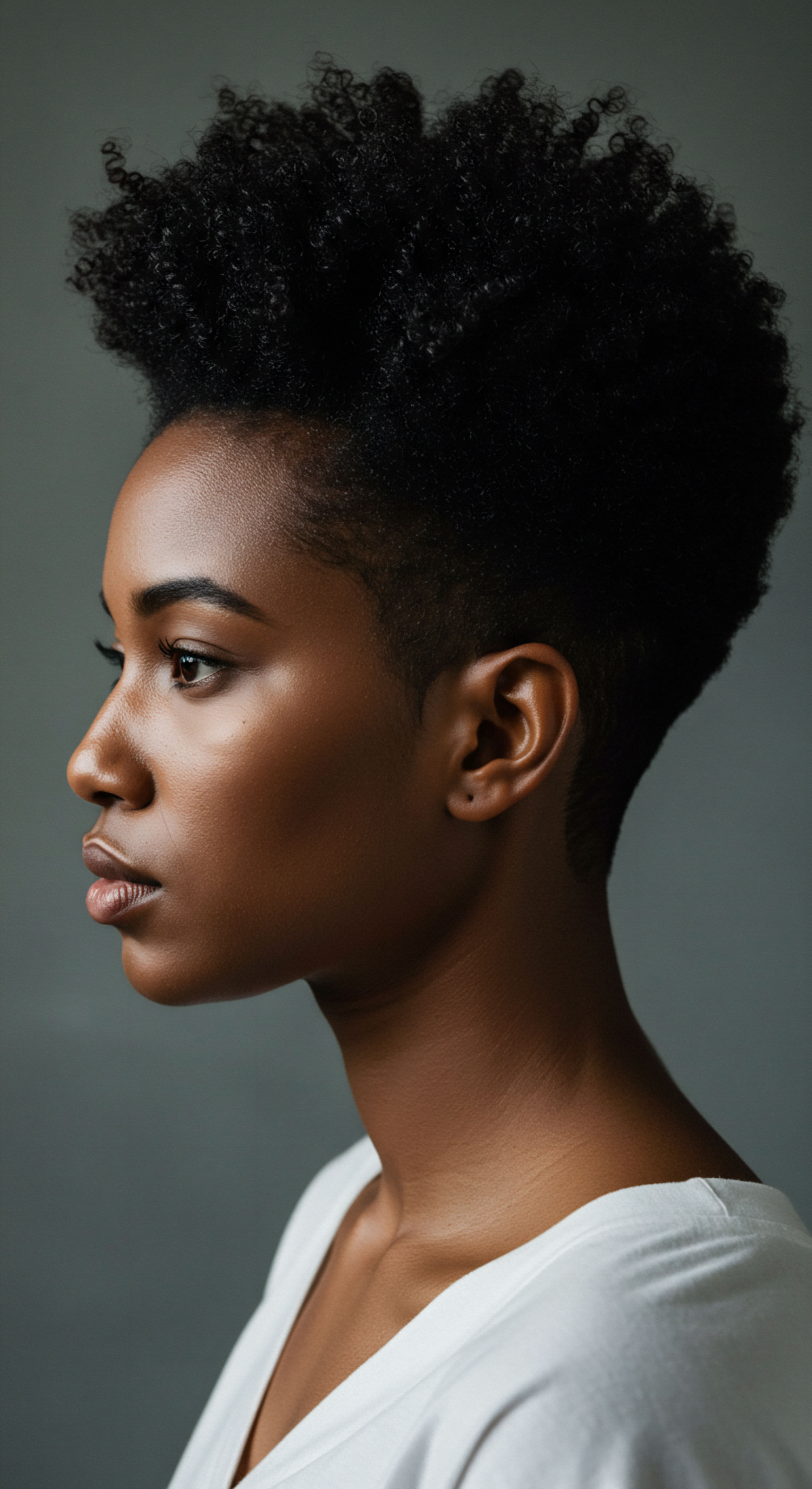
Roots
The quiet rhythm of water, a fundamental element, has always held a deep connection to human existence. From the gentle cascade of a mountain spring to the vast expanse of an ancient river, water has shaped civilizations, sustained life, and, in ways often overlooked, influenced our very rituals of personal care. For those with textured hair, this elemental connection holds particular significance. The interaction between water and hair, especially coils and curls, is a delicate dance, a dialogue between the external environment and our intrinsic nature.
Understanding this relationship, reaching back to the origins of human ingenuity and our shared history with water, offers a fresh perspective on modern hair care. It beckons us to consider how our ancestors, without the benefit of today’s scientific tools, instinctively understood water’s properties and its profound impact on hair.
Consider the daily experiences that echo across millennia ❉ the way water from a particular well might leave hair feeling different than water from a distant stream. These subtle variations, once felt and observed, guided ancient practices. They are the whispers of a wisdom that recognized water not as a uniform substance, but as a living entity with distinct characteristics.
This wisdom, passed through generations, shaped early cleansing methods and conditioning treatments. It is a heritage of observation and adaptation, offering profound lessons for contemporary textured hair care routines.

Water Chemistry in Ancient Times
Water, in its purest form, is a simple molecule, H2O. Yet, its journey through earth and sky imbues it with a unique chemical signature. In ancient times, people relied on natural sources ❉ rainwater, rivers, lakes, and underground springs. Each source possessed varying levels of dissolved minerals, gases, and organic matter, creating what we now term ‘water chemistry.’ The mineral content, in particular, played a significant role.
Water flowing through limestone or chalk bedrock, common in many parts of the world, would naturally accumulate calcium and magnesium ions, rendering it “hard”. Conversely, rainwater, collected directly, or water from areas with granite rock, would typically be “soft,” containing fewer dissolved minerals.
The pH level, a measure of acidity or alkalinity, also varied greatly in ancient water sources. Rainwater tends to be slightly acidic, while water interacting with certain geological formations can become more alkaline. These natural variations, though perhaps not understood in precise scientific terms by our ancestors, were undoubtedly perceived through their effects on hair and skin. A softer, slightly acidic rinse might leave hair feeling pliable and soft, while a harder, more alkaline wash could result in dryness and tangles.
Ancient observations of water’s interaction with hair, influenced by its unique mineral content and pH, laid the groundwork for early hair care traditions.

Early Hair Cleansing Methods and Water’s Role
Before the advent of modern shampoos, ancient civilizations developed ingenious methods for hair cleansing, often leveraging the properties of local water and natural ingredients. These practices were not random acts, but rather carefully developed rituals informed by centuries of observation.
- Ash and Lye ❉ In some cultures, wood ash, when mixed with water, created a rudimentary lye solution. This alkaline mixture, though harsh by today’s standards, possessed cleansing properties by reacting with oils to form a kind of soap. The efficacy of such a wash would be highly dependent on the water’s initial mineral content; softer water would likely yield a less abrasive solution.
- Clay and Earths ❉ Clays like rhassoul clay, sourced from regions in North Africa, were mixed with water to form cleansing pastes. These clays, rich in minerals, could absorb impurities and oils from the hair and scalp. The mineral composition of the water used to prepare these pastes would influence the final product’s consistency and cleansing power.
- Herbal Infusions and Plant Saponins ❉ Across various cultures, plants containing saponins, natural soap-like compounds, were used for washing. Yucca root in Native American traditions and soapberry (reetha) in ancient Indian Ayurvedic practices are prime examples. These plant materials, when steeped in water, released their cleansing agents. The quality of the water, its purity, and mineral presence, would undoubtedly impact the effectiveness of these natural lathers. Herbal rinses, using plants like rosemary, nettle, or chamomile, were also common, often serving to condition or add shine.
- Fermented Rice Water ❉ A particularly compelling example comes from ancient Asia, where fermented rice water has been used for centuries, notably by the Yao women of Huangluo village in China, famed for their exceptionally long hair. This practice, dating back to the Tang Dynasty, involves rinsing hair with water that has soaked or fermented rice. The water, now enriched with amino acids, vitamins, and antioxidants, becomes a conditioning agent that strengthens strands and reduces breakage. The fermentation process itself alters the water’s chemistry, making it slightly acidic, which is beneficial for hair cuticles.
These diverse historical practices underscore a fundamental truth ❉ water was not merely a vehicle for cleansing agents; it was an active participant in the hair care process. Its inherent qualities dictated the effectiveness of natural ingredients and shaped the traditions that endured for generations.

Ritual
Stepping from the quiet wisdom of origins, we arrive at the living practices, the rhythmic gestures that bring ancient understanding into daily being. For those of us tending textured hair, the wash day, the styling session, the nightly wrap—these are more than tasks; they are rituals. They are moments when we engage with our hair, nurturing its unique spirit, guided by a deep-seated desire for health and vitality.
This section delves into the practical application of water chemistry insights, bridging the past’s gentle wisdom with the present’s scientific clarity. It offers a space to consider how the water we use today shapes our strands, and how a mindful approach, informed by history and science, can transform our routines into acts of profound self-care.
We seek not simply to clean, but to cultivate, to bring forth the inherent beauty of each coil and curl. The quality of the water flowing from our taps, often unseen and unconsidered, holds a significant influence over this cultivation. It can either aid our efforts or present subtle, persistent challenges.

What is Hard Water and How Does It Affect Textured Hair?
Modern plumbing brings us water from various sources, often treated and transported, yet its underlying chemistry remains. “Hard water,” characterized by a high concentration of dissolved minerals, primarily calcium and magnesium, is a common reality for many. These minerals are picked up as water passes through geological formations like limestone and chalk. While not harmful to drink, hard water can significantly impact textured hair.
The effects on textured hair are particularly pronounced due to its unique structure. Textured hair, with its varying curl patterns, tends to be more porous than straight hair, meaning its cuticle layers can be more open. This open structure allows mineral ions from hard water to penetrate and cling to the hair shaft more readily.
Consider the following impacts of hard water on textured hair:
- Dryness and Brittleness ❉ Mineral buildup creates a film on the hair, hindering moisture absorption. This can leave textured hair feeling dry, rough, and brittle, even after applying moisturizing products.
- Reduced Lather and Product Effectiveness ❉ The minerals in hard water react with surfactants in shampoos, reducing their ability to lather effectively. This means more product is needed to achieve a clean feel, and conditioners may not penetrate as deeply.
- Dullness and Lack of Shine ❉ Mineral deposits on the hair surface can prevent light from reflecting properly, leading to a dull, lifeless appearance.
- Increased Frizz and Tangles ❉ Hard water can alter the hair’s natural texture, making it rougher and more difficult to manage. The mineral buildup can lift the hair cuticle, causing increased friction between strands and contributing to frizz and tangles, especially in curly hair. A 2020 study published in the International Journal of Trichology supported this, finding that participants using soft water reported a significant reduction in frizz and improved manageability.
- Scalp Irritation ❉ Mineral residue can accumulate on the scalp, potentially clogging hair follicles and leading to dryness, irritation, and flakiness.

Does Water PH Matter for Textured Hair Health?
Beyond mineral content, the pH of water plays a silent yet significant role in hair health. pH measures how acidic or alkaline a substance is, on a scale of 0 to 14, with 7 being neutral. Hair and scalp naturally exist in a slightly acidic state, typically between 4.5 and 5.5. This acidic mantle helps keep the cuticle layer of the hair flat and smooth, protecting the inner cortex and maintaining moisture.
Water with a high pH (alkaline water), common in many hard water areas, can disrupt this delicate balance. When hair is exposed to alkaline water, the cuticle layers can lift, increasing the hair’s negative electrical charge and leading to increased friction, frizz, and breakage. This effect is particularly pertinent for textured hair, which already has a cuticle that can be more prone to lifting due to its structural bends and curves.
Conversely, slightly acidic rinses, like those historically used with vinegar or citrus juice, help to seal the cuticle, promoting shine and reducing frizz. This ancient wisdom aligns perfectly with modern scientific understanding of hair pH.
Understanding water’s hardness and pH is a key step toward transforming textured hair care, allowing for routines that truly serve each strand.

Traditional Rinses and Modern Counterparts
The practices of old offer more than just historical anecdotes; they present blueprints for gentle, effective care. The ancient use of acidic rinses, such as diluted vinegar or citrus juice, after washing was a simple yet profound method to counteract the effects of alkaline cleansing agents or hard water. These rinses helped to restore the hair’s natural pH, smooth the cuticle, and impart shine.
Today, we find parallels in modern textured hair care. Many products are formulated to be pH-balanced, ensuring they do not disrupt the hair’s natural acidity. Additionally, apple cider vinegar rinses remain a popular natural remedy to clarify hair and rebalance pH, directly mirroring ancient practices.
| Ancient Practice Fermented Rice Water (Yao women) |
| Observed Benefit Hair strength, reduced breakage, length retention |
| Modern Parallel / Scientific Link Protein treatments, amino acid-rich formulas; inositol strengthens hair from within |
| Ancient Practice Vinegar/Citrus Rinses (Ancient Greeks, Romans, Egyptians, Victorians) |
| Observed Benefit Shine, cuticle smoothing, counteracting alkalinity |
| Modern Parallel / Scientific Link pH-balanced shampoos, acidic rinses (e.g. apple cider vinegar) |
| Ancient Practice Herbal Infusions (European, Ayurvedic) |
| Observed Benefit Cleansing, conditioning, subtle highlights |
| Modern Parallel / Scientific Link Herbal extracts in shampoos/conditioners, natural clarifying rinses |
This continuum of wisdom, from ancient observation to modern scientific validation, underscores the enduring power of simple, mindful practices.

Relay
From the gentle whispers of ancestral practices, we now step into a realm where the profound depths of science and culture converge, illuminating the subtle yet powerful influence of water chemistry on textured hair. This is not merely about understanding what happens at the strand level, but how these microscopic interactions echo through our lived experiences, our sense of identity, and the very health of our hair. It is an invitation to consider the intricate dance between ancient wisdom and contemporary research, revealing how insights from bygone eras can truly transform our approach to modern textured hair care. We seek to unravel the complexities, recognizing that every drop of water carries a story, a history that can inform our present choices.

How Does Hard Water Impair Hair Structure and Color Vibrancy?
The impact of hard water extends beyond mere dryness; it can structurally compromise the hair fiber and diminish its vibrancy. The calcium and magnesium ions, carrying positive electrical charges, are drawn to the negatively charged sites on the hair’s cuticle, especially where damage or porosity exists. This attraction results in a layer of mineral deposits accumulating on the hair shaft.
This mineral coating creates a rough, stiff outer layer, impeding the hair’s natural flexibility and making it more susceptible to breakage. A 2018 study, for example, found that 10 minutes of exposure to hard water every other day over three months significantly decreased the tensile strength of hair samples, making them more likely to break under tension. While some studies suggest no significant impact on tensile strength from shorter exposure, the cumulative effect of long-term hard water exposure is a consistent concern for hair health.
Beyond structural integrity, hard water also poses a challenge to hair color. Minerals, particularly copper and iron, can react with hair dyes, leading to unwanted color shifts, brassiness, or a dull appearance. These metals can also participate in “metal-induced radical chemistry” during coloring, interfering with how well a new hue takes hold. For those who color-treat their textured hair, this means the water quality can directly sabotage the desired outcome, leading to frustration and the need for more frequent color corrections.

What Can Chelating Agents Teach Us About Mineral Removal?
The challenge of mineral buildup in hair is not new. While ancient cultures might have used acidic rinses to some effect, modern science has introduced powerful tools ❉ chelating agents. These specialized compounds act like microscopic “claws,” binding to metal ions (like calcium, magnesium, iron, and copper) and rendering them soluble, allowing them to be rinsed away from the hair shaft.
Chelating agents such as Disodium EDTA (ethylene diamine tetraacetic acid) are common in clarifying shampoos and treatments today. Their ability to sequester metal ions means they can:
- Remove Build-Up ❉ They effectively lift and wash away mineral deposits that contribute to dryness, dullness, and stiffness.
- Restore Product Effectiveness ❉ By clearing the mineral barrier, chelating agents allow conditioners and other hair care products to penetrate the hair shaft more deeply and perform as intended.
- Enhance Hair Texture and Shine ❉ With minerals removed, hair can regain its natural softness, flexibility, and reflective quality.
- Preserve Color ❉ By preventing metal interference, chelating agents help maintain the vibrancy and longevity of dyed hair.
This scientific understanding of chelation offers a direct, actionable solution to a problem exacerbated by modern water infrastructure. It provides a contemporary parallel to the ancient recognition that water’s contents significantly impact hair, offering a precise method for mitigation.

Can Traditional Fermentation Practices Inform Modern Hair Hydration?
The ancient practice of using fermented rice water, particularly by the Yao women, provides a compelling case study in how subtle changes to water chemistry can yield profound benefits for hair. The fermentation process transforms rice water, increasing its concentration of beneficial compounds like inositol, amino acids, and vitamins B and E.
Inositol, a carbohydrate, is particularly notable as it has the ability to penetrate the hair shaft, strengthening it from within and helping to repair damage. This internal reinforcement contributes to increased elasticity and reduced breakage, outcomes highly sought after in textured hair care.
The pH of fermented rice water also plays a role. While initial rice water might be close to neutral, fermentation can lead to a slightly acidic pH, which helps to flatten and seal the hair cuticle. This smoothing effect contributes to reduced frizz and enhanced shine, aligning with the hair’s natural acidic state.
This traditional practice offers several lessons for modern hydration strategies:
- Bioavailability ❉ Fermentation can make nutrients more bioavailable, meaning they are more easily absorbed by the hair and scalp.
- PH Balance ❉ The subtle acidity achieved through fermentation mirrors the optimal pH for hair health, promoting cuticle closure and smoothness.
- Holistic Approach ❉ It highlights how a simple, natural ingredient, when prepared with understanding, can provide a multi-faceted benefit, addressing strength, hydration, and appearance simultaneously.
This ancestral method, now gaining traction in modern beauty discourse, serves as a powerful reminder that sometimes the most sophisticated solutions lie in a deep understanding of natural processes and their gentle manipulation. It encourages us to look beyond synthetic ingredients and consider how natural transformations of water and its botanical companions can truly nourish textured hair.

Reflection
The journey through ancient water chemistry and its resonance with modern textured hair care unveils a profound truth ❉ the quest for vibrant, healthy hair is a timeless human endeavor, deeply rooted in our relationship with the natural world. From the instinctive wisdom of our ancestors, who observed and adapted to the nuances of their local water sources, to the precision of contemporary science dissecting mineral interactions and pH balances, a consistent message echoes. Water, in its elemental purity and its complex compositions, holds keys to our hair’s well-being. By honoring the historical understanding of water’s qualities and applying modern scientific insights, we can cultivate routines that truly cherish the unique character of textured strands, allowing them to flourish in their innate glory.

References
- Hefford, R. J. W. (2018). Exploring hair care materials past and present. Cosmetics Business.
- Dupont, F. (Year unknown). Daily Life in Ancient Rome.
- S.P.L. Sørensen. (1909). Original work on pH scale.
- Reetha (Indian soapberry), Amla (Indian gooseberry), Hibiscus, Shikakai (Acacia). Ancient Indian Ayurvedic texts.
- Yao women of Huangluo village, China. Cultural tradition, passed down through generations.
- Water Quality & Health Council. (2018). Study on skin dryness after water softener installation.
- National Hairdressing Federation. (2019). Consumer survey on hair shine with softeners.
- International Journal of Trichology. (2014). Study on alkaline pH and hair fiber surface charge.
- Journal of Cosmetic Science. (2017). Study on soft water, curl definition, and frizz.
- International Journal of Dermatology. (2015). Study on hard water effects on hair thickness.
- Journal of Cosmetic Dermatology. (Year unknown). Study on alkaline ionized water, hair density, and hair loss.
- Journal of the American College of Nutrition. (Year unknown). Study on alkaline ionized water, antioxidant status, and oxidative stress.
- Suetonius. (Year unknown). The Twelve Caesars.
- Ovid. (Year unknown). Ars Amatoria.
- Dr. Emma Richardson. (Year unknown). Dermatologist specializing in hair health.
- Dr. Amanda Lee. (Year unknown). Trichologist with over 15 years of industry experience.